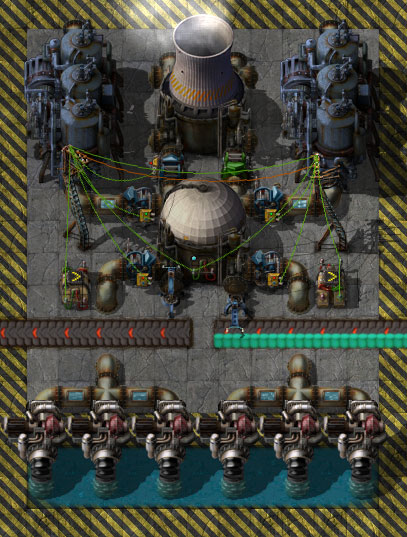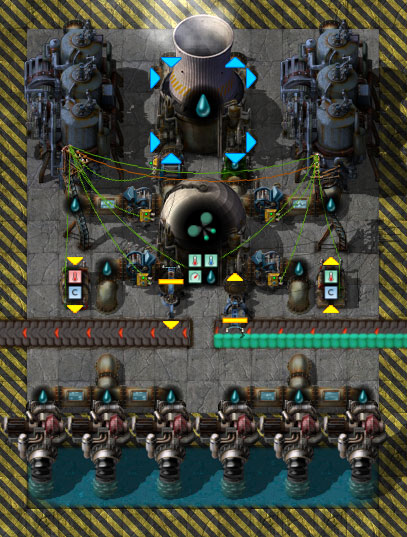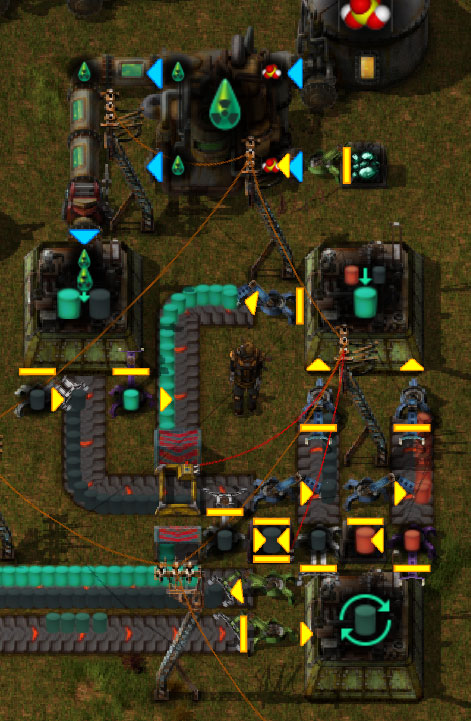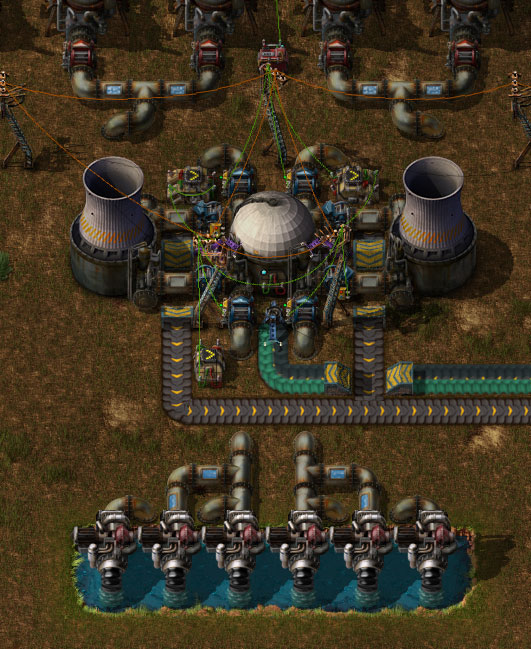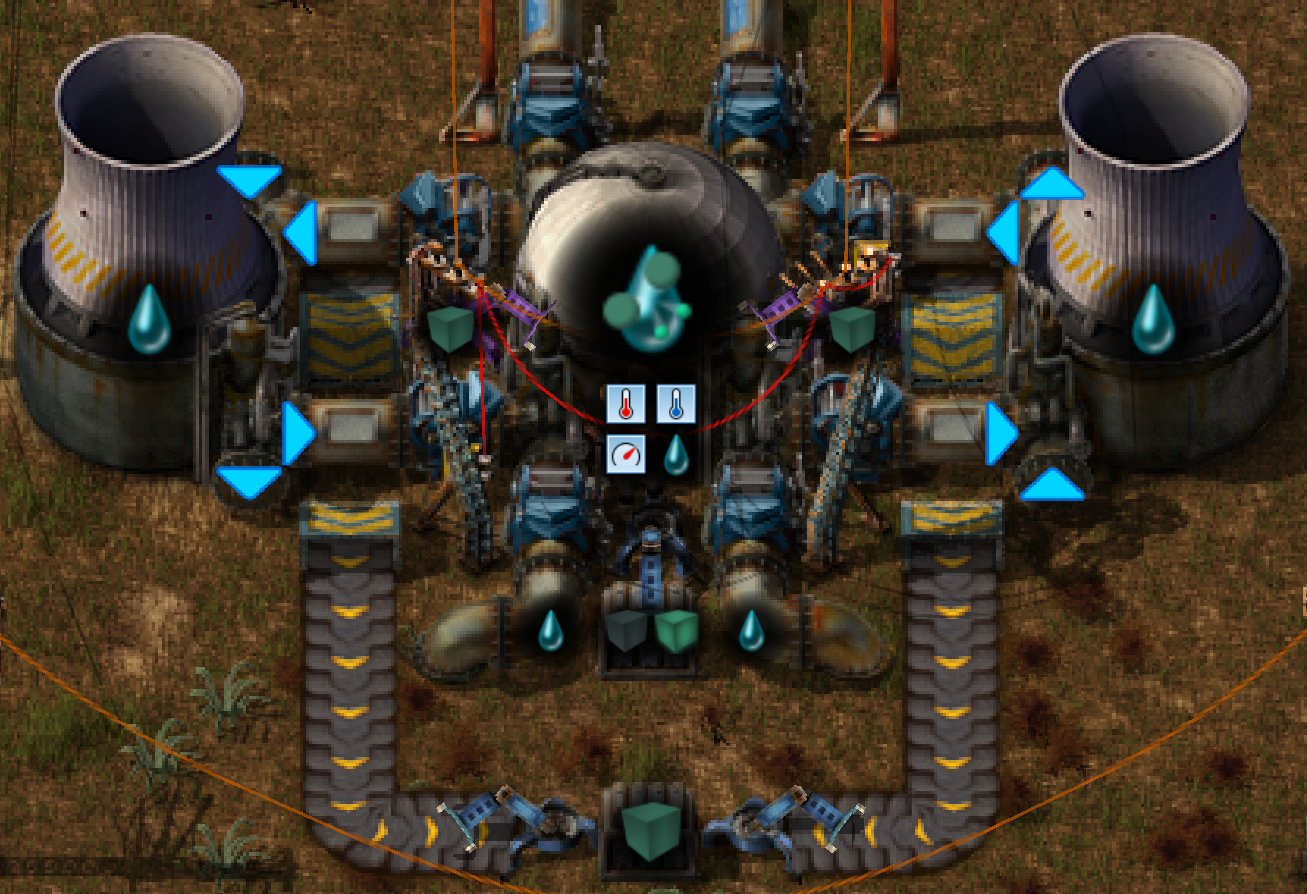[0.14] Reactors & Atomic Locomotives
Posted: Sun Sep 25, 2016 4:20 am
Discussion/feedback/suggestions thread for Reactors and Atomic Locomotives
Flow Control (or a similar mod that adds high-speed pumps) is required. Reactors need a lot of water.
Reactors adds nuclear reactors, uranium and plutonium, along with recipes and technologies to make use of them. Each reactor produces 26 MW, enough to run 50 steam engines or 2 steam turbines (the turbine is a compact shortcut for 25 steam engines, it's no more or less efficient except in terms of space).
Turbines come in two types, base load (primary priority) and peak load (secondary priority).
Atomic Locomotives adds a heavy, powerful locomotive that's filled with plutonium at the factory and needs no further refuelling.
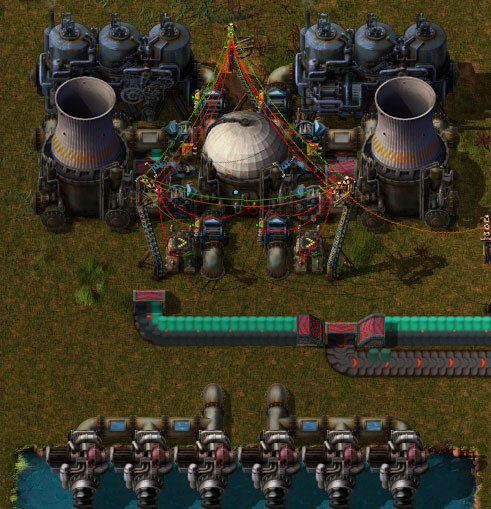
Initially, an inefficient simple fission cycle produces power, marginally-useful byproducts and also waste. Subsequent research provides for reprocessing this waste into byproducts so it can at least be used rather than merely stored. Further research allows recycling of byproducts to fuel, and finally a breeder cycle that can be used (along with fission) to re-enrich processed waste and result in a zero-residue fuel cycle. Or you might deliberately run a surplus of one or more byproducts.
Reactors have a 500-unit fluid tank, and when they are active (with a recipe set) they heat fluid in this tank, which you can use to power steam engines/turbines. Reactors produce up to 26 MW (slightly more than needed to run 50 steam engines or 2 turbines).
Reactors will attempt to maintain an internal temperature of 150°C by increasing/decreasing their power production. Water in the core is heated to a maximum of 100°C, cooling the core in the process. Thus the more hot water you're using, the more power the reactor will have to produce to maintain its temperature. Reactors will not reduce power below 20%.
If a reactor core's temperature rises above 200°C, it will enter emergency shutdown mode. In this mode, power output is set to 0, and will not be enabled again until the core temperature has been reduced to 16°C (through water cooling).
Cooling towers can protect your reactor from overheating. They accept water of any temperature, and output (slightly less) water at 15°C. Using pumps and circuit conditions, you can set up your cooling towers to only activate when the reactor is beginning to overheat (or is in emergency shutdown). I prefer to set mine to activate at 160°C.
IMPORTANT: If your reactor is full of fluid, your cooling towers will not be able to push their cold water back in. For this reason I set my water intake pumps to only turn on if the reactor is <80% full.
Reactor signals
All signals are emitted/read from the circuit interface on the front of the reactor.
Output
 Reactor core temperature
Reactor core temperature
 Reactor coolant temperature - the temperature of the fluid in the heat exchanger
Reactor coolant temperature - the temperature of the fluid in the heat exchanger
 Reactor power output - as a percentage
Reactor power output - as a percentage
 Reactor shutting down - emitted while the reactor is throttling down after receiving a shutdown command, sending this signal to the reactor has no effect
Reactor shutting down - emitted while the reactor is throttling down after receiving a shutdown command, sending this signal to the reactor has no effect
 Reactor overheated - this signal will be output while the reactor is in its emergency shutdown state, sending this signal to the reactor has no effect
Reactor overheated - this signal will be output while the reactor is in its emergency shutdown state, sending this signal to the reactor has no effect
Input
 Reactor target output (percentage) - Overrides automatic throttle if this signal is greater than zero. Does not remove minimum throttle of 20%. The main use of this signal is to force a reactor to run at max speed for faster production.
Reactor target output (percentage) - Overrides automatic throttle if this signal is greater than zero. Does not remove minimum throttle of 20%. The main use of this signal is to force a reactor to run at max speed for faster production.
 Shut down reactor - If the reactor receives this signal it will reduce power to zero and halt operation. It will continue shutting down even if the signal is removed, until its output reaches zero.
Shut down reactor - If the reactor receives this signal it will reduce power to zero and halt operation. It will continue shutting down even if the signal is removed, until its output reaches zero.
A reactor using the fission cycle produces only half as much plutonium (via waste reprocessing) as it needs to re-enrich its fuel. A reactor using the breeder cycle produces twice its own plutonium needs. If you use only basic fission, you will produce large amounts of depleted uranium. If you only use breeders, you will run a slow but steady plutonium surplus.
Note that reactors don't have to be used to produce power - you might find it simpler to produce all your power from basic fission, and have a breeder reactor forced to run at full speed through the attachment of two actively-pumped cooling towers.
Sometimes you may notice your reactor is not outputting water at 100°C. This is due to the order in which pipes, tanks and pumps update their volume and temperature.
To get reliably hot output, make sure your reactor and its pumps are within the same chunk (use the F4 menu to show tile grid, and note the thicker black lines), and build your output pumps (i.e. pumps sending hot water to the engines) before the input pumps (i.e. cold water intake) and reactor.
Flow Control (or a similar mod that adds high-speed pumps) is required. Reactors need a lot of water.
Reactors adds nuclear reactors, uranium and plutonium, along with recipes and technologies to make use of them. Each reactor produces 26 MW, enough to run 50 steam engines or 2 steam turbines (the turbine is a compact shortcut for 25 steam engines, it's no more or less efficient except in terms of space).
Turbines come in two types, base load (primary priority) and peak load (secondary priority).
Atomic Locomotives adds a heavy, powerful locomotive that's filled with plutonium at the factory and needs no further refuelling.

Initially, an inefficient simple fission cycle produces power, marginally-useful byproducts and also waste. Subsequent research provides for reprocessing this waste into byproducts so it can at least be used rather than merely stored. Further research allows recycling of byproducts to fuel, and finally a breeder cycle that can be used (along with fission) to re-enrich processed waste and result in a zero-residue fuel cycle. Or you might deliberately run a surplus of one or more byproducts.
Technology Tree
Fuel Cycle
Reactor mechanicsReactors have a 500-unit fluid tank, and when they are active (with a recipe set) they heat fluid in this tank, which you can use to power steam engines/turbines. Reactors produce up to 26 MW (slightly more than needed to run 50 steam engines or 2 turbines).
Reactors will attempt to maintain an internal temperature of 150°C by increasing/decreasing their power production. Water in the core is heated to a maximum of 100°C, cooling the core in the process. Thus the more hot water you're using, the more power the reactor will have to produce to maintain its temperature. Reactors will not reduce power below 20%.
If a reactor core's temperature rises above 200°C, it will enter emergency shutdown mode. In this mode, power output is set to 0, and will not be enabled again until the core temperature has been reduced to 16°C (through water cooling).
Cooling towers can protect your reactor from overheating. They accept water of any temperature, and output (slightly less) water at 15°C. Using pumps and circuit conditions, you can set up your cooling towers to only activate when the reactor is beginning to overheat (or is in emergency shutdown). I prefer to set mine to activate at 160°C.
IMPORTANT: If your reactor is full of fluid, your cooling towers will not be able to push their cold water back in. For this reason I set my water intake pumps to only turn on if the reactor is <80% full.
Reactor signals
All signals are emitted/read from the circuit interface on the front of the reactor.
Output
 Reactor core temperature
Reactor core temperature Reactor coolant temperature - the temperature of the fluid in the heat exchanger
Reactor coolant temperature - the temperature of the fluid in the heat exchanger Reactor power output - as a percentage
Reactor power output - as a percentage Reactor shutting down - emitted while the reactor is throttling down after receiving a shutdown command, sending this signal to the reactor has no effect
Reactor shutting down - emitted while the reactor is throttling down after receiving a shutdown command, sending this signal to the reactor has no effect Reactor overheated - this signal will be output while the reactor is in its emergency shutdown state, sending this signal to the reactor has no effect
Reactor overheated - this signal will be output while the reactor is in its emergency shutdown state, sending this signal to the reactor has no effectInput
 Reactor target output (percentage) - Overrides automatic throttle if this signal is greater than zero. Does not remove minimum throttle of 20%. The main use of this signal is to force a reactor to run at max speed for faster production.
Reactor target output (percentage) - Overrides automatic throttle if this signal is greater than zero. Does not remove minimum throttle of 20%. The main use of this signal is to force a reactor to run at max speed for faster production. Shut down reactor - If the reactor receives this signal it will reduce power to zero and halt operation. It will continue shutting down even if the signal is removed, until its output reaches zero.
Shut down reactor - If the reactor receives this signal it will reduce power to zero and halt operation. It will continue shutting down even if the signal is removed, until its output reaches zero.Example Reactor
Example Fuel Processing
OptimisationA reactor using the fission cycle produces only half as much plutonium (via waste reprocessing) as it needs to re-enrich its fuel. A reactor using the breeder cycle produces twice its own plutonium needs. If you use only basic fission, you will produce large amounts of depleted uranium. If you only use breeders, you will run a slow but steady plutonium surplus.
Note that reactors don't have to be used to produce power - you might find it simpler to produce all your power from basic fission, and have a breeder reactor forced to run at full speed through the attachment of two actively-pumped cooling towers.
Sometimes you may notice your reactor is not outputting water at 100°C. This is due to the order in which pipes, tanks and pumps update their volume and temperature.
To get reliably hot output, make sure your reactor and its pumps are within the same chunk (use the F4 menu to show tile grid, and note the thicker black lines), and build your output pumps (i.e. pumps sending hot water to the engines) before the input pumps (i.e. cold water intake) and reactor.
Reactors version history
Atomic Locomotives version history
